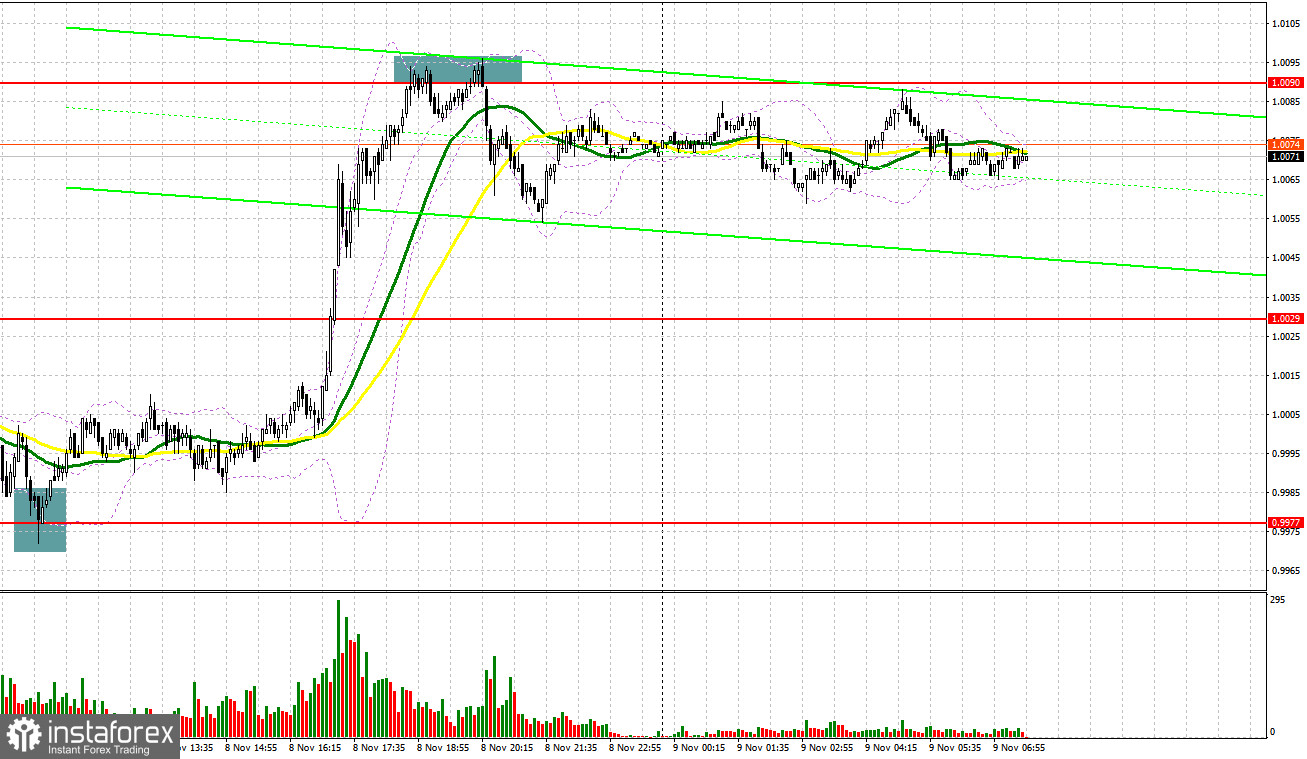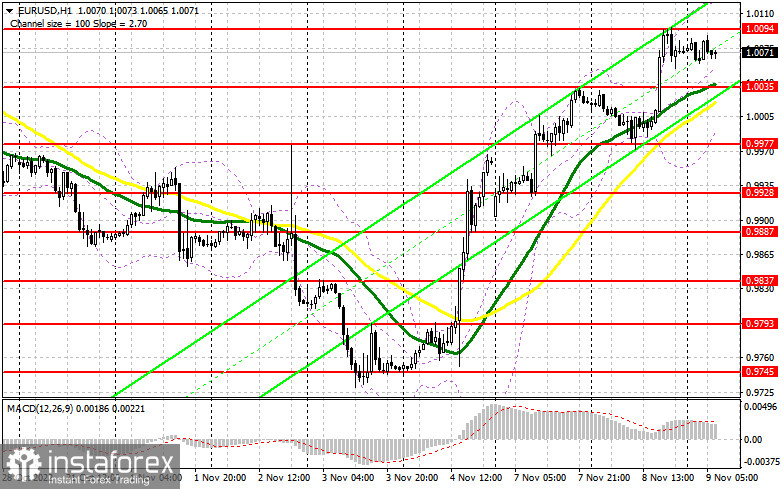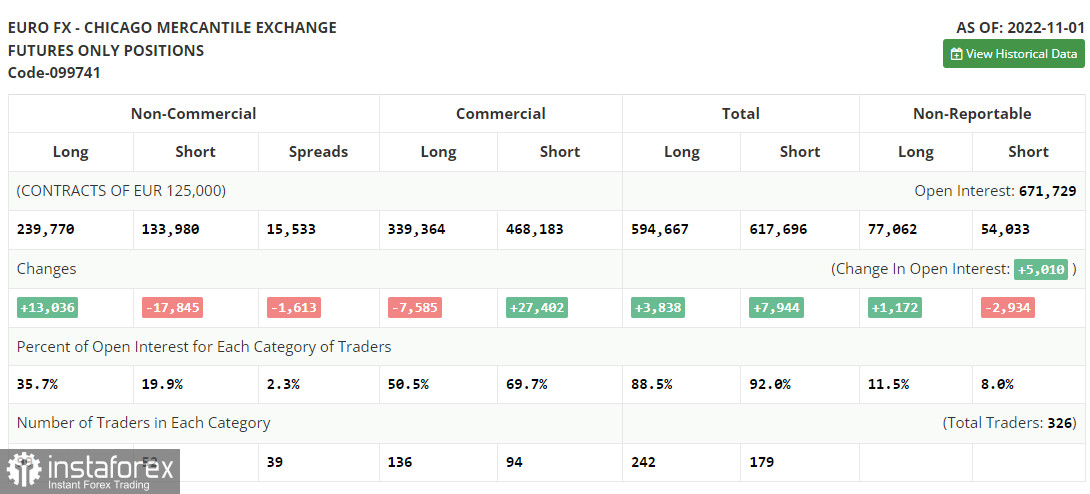Yesterday, traders received several interesting signals to enter the market. Let us take a look at the 5-minute chart to figure out what happened. Earlier, I asked you to pay attention to 0.9977 to decide when to enter the market. A decline and false breakout of this level provided bulls with a perfect entry point, however, it did not result in a sharp rise in the morning. The bulls did not receive support from big players and statistics, and after moving up by 25 points, the pair froze. During the US session and the start of the midterm elections in the US, the dollar began to quickly lose ground amid a decrease in the yield of US bonds, which caused the pair to surge and update the resistance at 1.0090. A false breakout there gave a signal to sell, which resulted in a move down by 40 points.

When to go long on EUR/USD:
The euro has come close to the October high and is already aiming to surpass it. The fact that the bulls managed to stay above parity will make it possible for us to expect an upward correction, however, in this case, strong fundamental statistics is necessary. Today, there are no economic statistics that can harm the euro, and only a speech by a member of the European Central Bank Executive Board, Frank Elderson, is expected, which the market will probably ignore. That is why the bulls need to surpass and settle above the October high as well as above yesterday's high at 1.0094. But do not forget that tomorrow we will receive data on US inflation, which can turn everything upside down. Therefore, in the current conditions, I don't think buying at the highs would be the right decision.
It is best to wait for the EUR/USD to fall, and after a false breakout around 1.0035, where the moving averages also pass, you can open long positions in order to continue the bullish trend observed since last Friday. A breakout and downward test of 1.0094 will open a direct path to 1.0136, a more significant level where bears should prove themselves, if they actually remained. Surpassing this level would hit the bears' stops and form an additional buy signal with the possibility of a push up to the 1.0182 area, which would strengthen the bullish trend.
If the pair falls and bulls fail to protect 1.0035, then the pair will be under pressure, leading to a downward move towards 0.9977, from where you could observe excellent longs yesterday. The best decision to buy would be a false breakout in that level. It is also possible to go long after a bounce from 0.9928, or even lower - from 0.9887, expecting a rise of 30-35 pips.
When to go short on EUR/USD:
The bears tried to return to the market yesterday, but the start of the US midterm elections affected those who wanted to buy the dollar, which led to another upward spurt for the pair. The expected victory of the Republicans will continue to put pressure on the US dollar, because the victory of the Democrats is more preferable. Considering that there are no important statistics today, bears need to protect the nearest resistance at 1.0094 in the morning. The best decision to sell would be a false breakout there after the speech of the ECB representatives, which will provide an excellent entry point and allow you to return to 1.0035 - an intermediate support formed on the basis of yesterday.
Settling below this range, as well as a reverse test upwards, will be a reason to sell EUR/USD in order to remove bullish stops and a larger drop to the 0.9977 area ahead of tomorrow's US inflation data. Bears will face serious problems at that level, as a rather strong downward correction will bring bulls back into the market. The farthest target will be the area of 0.9928, where I recommend locking in profits.
If EUR/USD moves up during the European session and bears fail to protect 1.0094, the demand for the pair will increase, which will support the bull market and an update of 1.0136. In this case, I advise you not to rush into selling: I recommend opening shorts there only after a false breakout. It is also possible to go short after a rebound from the high of 1.0182, or even higher - from 1.0218, expecting a decline of 30-35 pips.

COT report:
According to the recent Commitment of Traders (COT) report from November 1, the number of both short and long positions dropped. The US dollar continues losing value against risk assets despite the fact that the US Fed remains stuck to its approach. Most traders suppose that the regulator will end its aggressive tightening as early as next spring. After that, it is likely to start cutting the key interest rate quite smoothly. This may considerably boost demand for the euro. This week, such a rise could be triggered by the US inflation report, which has been shaping the Fed's approach. If inflation declines, the US dollar will lose value and the euro will confidently consolidate above the parity level. However, the bullish potential of the euro is also limited. The fact is that the ECB may revise its aggressive monetary policy after a sharp rise in the key interest rate. However, this will happen if the eurozone economy continues contracting. The COT report unveiled that the number of long non-commercial positions increased by 13,036 to 239,770, while the number of short positions dropped by 17,845 to 133,980. At the end of the week, the total non-commercial net position remained positive at 105,790 against 74,909. This indicates that investors continue benefiting from the situation and buying the cheap euro below parity, as well as accumulating long positions, expecting the end of the crisis. The weekly closing price rose to 0.9918 from 1.0000.

Signals of indicators:
Moving averages
Trading is performed above the 30- and 50-day moving averages, which indicates the euro's growth.
Note: The period and prices of moving averages are considered by the author on the one-hour chart, which differs from the general definition of the classic daily moving averages on the daily chart.
Bollinger Bands
If the euro/dollar pair rises, the upper limit of the indicator located at 1.0125 will act as resistance. If the pair drops, the lower limit of the indicator around 1.0000 will act as support.
Description of indicators
- Moving average (moving average, determines the current trend by smoothing volatility and noise). The period is 50. It is marked in yellow on the chart.
- Moving average (moving average, determines the current trend by smoothing volatility and noise). The period is 30. It is marked in green on the graph.
- MACD indicator (Moving Average Convergence/Divergence - convergence/divergence of moving averages). A fast EMA period is 12. A slow EMA period is 26. The SMA period is 9.
- Bollinger Bands. The period is 20.
- Non-profit speculative traders are individual traders, hedge funds, and large institutions that use the futures market for speculative purposes and meet certain requirements.
- Long non-commercial positions are the total number of long positions opened by non-commercial traders.
- Short non-commercial positions are the total number of short positions opened by non-commercial traders.
- The total non-commercial net position is a difference in the number of short and long positions opened by non-commercial traders.
 English
English 
 Русский
Русский Bahasa Indonesia
Bahasa Indonesia Bahasa Malay
Bahasa Malay ไทย
ไทย Español
Español Deutsch
Deutsch Български
Български Français
Français Tiếng Việt
Tiếng Việt 中文
中文 বাংলা
বাংলা हिन्दी
हिन्दी Čeština
Čeština Українська
Українська Română
Română

